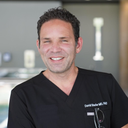I had transconjunctival Blepharoplasty 14 weeks ago. Right eye has healed, but left eye heals slow. There's a slight bulge directly beneath where the bag used to be (can't be fat, way too far from lid). If you were to place the tip of your thumb on a piece of paper, trace it with a pencil, that's the shape of it, with the rounded edge facing downwards. Is this residual swelling? Is it normal to have swelling in that region? Why do eyes heal at different rates? (Hard to see in photo, very apparent in person)
Answers (13)
From board-certified doctors and trusted medical professionals

Dr. Kenneth D. Steinsapir, MD
Oculoplastic Surgeon, Board Certified in Ophthalmology
Answer

Dr. Mark Berkowitz, MD
Oculoplastic Surgeon, Board Certified in Ophthalmology
Answer
Dr. Chris Thiagarajah, MD
Oculoplastic Surgeon, Board Certified in Ophthalmology
Answer


